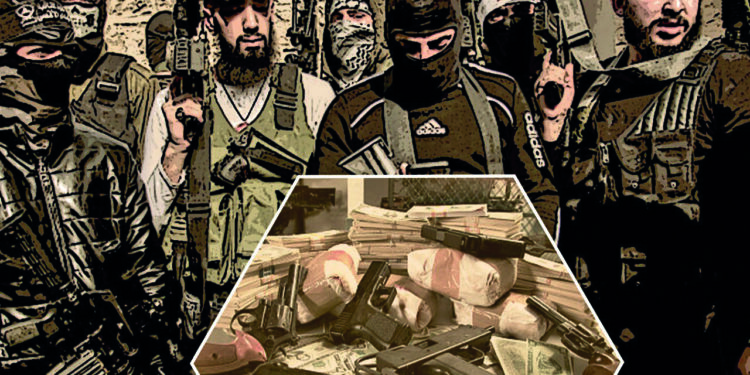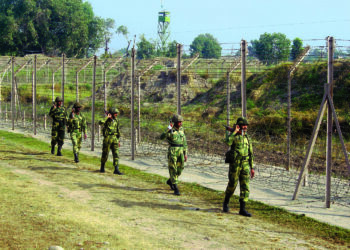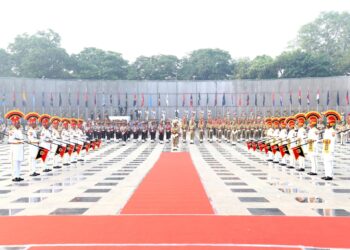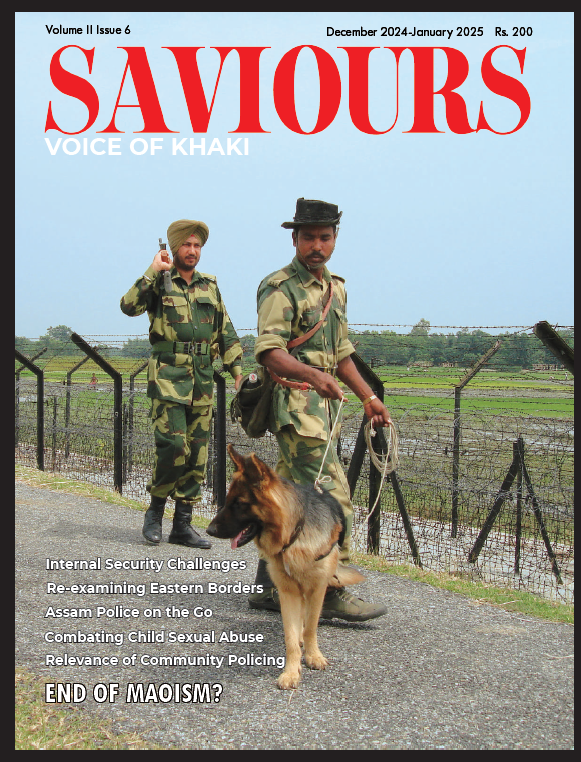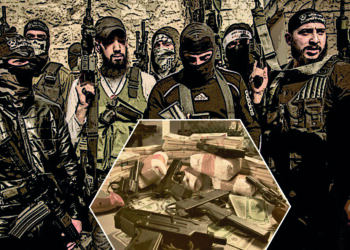Dr Harjit Sandhu, a noted UN and international Terrorism and Crime Investigator, discusses the contours and entire gamut of international terrorism through his long career with global bodies. It is a must-read for all security professionals, the legal community, the general public, and policymakers.
Introduction – A Journey Through Experience
Throughout my career spanning over four decades, I’ve encountered terrorism not just as a subject of policy or law enforcement but as a living, breathing threat with far-reaching consequences. Over the years, I have spoken on this subject in a variety of settings, including high-level law enforcement officials around the world. These presentations have been much more than mere academic briefings. This has been a reflection of years of personal observations and brushes with terrorism in my home country, as well as internationally in some of the most fragile and conflict areas.
Globalisation and Terrorism – A Double-Edged Reality
The threat of terrorism has evolved significantly over the past few decades. While once viewed as a distant, foreign phenomenon, terrorism today is an omnipresent challenge that transcends borders and cultures. Globalisation, while fostering economic and cultural interconnection, has also created fertile ground for extremist ideologies. It has magnified divisions and inequalities, offering new avenues for terrorism to spread, not causing it but facilitating its reach.
In the 1990s, the lowering of economic barriers enabled terrorist groups to establish transnational financial networks. Figures like Yousef Nada and Idris Nasreddin, linked to Osama bin Laden, developed business empires across Europe and Africa, demonstrating the adaptability of terrorist organisations in a globalised world. They operated under legitimate business fronts while funnelling resources to terror networks. According to UN findings, their assets reached hundreds of millions of dollars, clearly illustrating that terrorism had become a self-sustaining transnational venture.
No Region is Safe – A Truly Global Threat
It’s a dangerous delusion to think terrorism is confined to a specific geography. Before 9/11, many in the West saw terrorism as a problem for the Middle East or South Asia. That illusion shattered in a single morning. Since then, from Madrid to Mumbai, from Nairobi to New York, from Palwama to Pahalgam, terror has struck indiscriminately.
Terrorism has moved from battlefields into our drawing rooms. It affects how we fly, gather, and think. It’s been debated in parliaments, dissected in media rooms, and feared by ordinary citizens. No continent is immune. No country is untouched. And yet, often, our strategies remain siloed and reactionary.
Defining Terrorism – A Concept Without Consensus
One of the fundamental problems in counter-terrorism is the lack of a universally accepted definition of terrorism. Between 1936 and 1981, 109 different definitions of terrorism were proposed. None gained universal approval. This isn’t just an academic issue—it has practical consequences. Without a shared understanding, cooperation across borders becomes difficult.
The Encyclopedia Britannica defines terrorism as the “systematic use of violence (such as bombings, killings, and kidnappings) to achieve political objectives.” It highlights that when used by a government, it’s repression; when used by non-state actors, it’s insurgency or guerrilla warfare. But again, context matters.
The term “terrorism” itself originates from the French Revolution’s Reign of Terror, where violence was used to root out political enemies. Over a few months, more than 1,300 people were guillotined in Paris alone. This historical origin reminds us that terrorism isn’t a new phenomenon—it’s a political tool with centuries-old roots.
And yet, we still struggle to agree: Who is a terrorist?
For many Palestinians, Ariel Sharon’s targeted assassination of Sheikh Yasin was terrorism. To the Israeli state, it was a necessary act of self-defence against the head of Hamas. Which side is correct? Both? Neither?
Complicating matters further, perception plays a critical role. One group’s freedom fighter is another’s terrorist, depending on the observer’s political and cultural lens. This grey zone makes international cooperation challenging and, at times, hypocritical. Thus, counter-terrorism efforts must navigate operational challenges and complex narratives and perceptions. The author’s preferred definition of terrorism is the one given by Walter: “Like art or pornography, you know terrorism when you see it”.
The Power of Perception and the Human Cost
Terrorism, at its core, is about perception. It thrives on drama, spectacle, and media amplification. It is a theatre, and the world is its stage. People often ask me—What drives someone to kill civilians? To blow themselves up? The answer isn’t simple. Some are ideological purists. Others are radicalised intellectuals who feel wronged by systemic injustice. Some are criminals looking for a sense of identity or profit. Each terrorist has a story; if we fail to understand those stories, we’ll continue to misdiagnose the threat.
And then there are the law enforcers—often romanticised in movies as superheroes. But in reality, they are humans made of flesh and blood, dealing with trauma, fatigue, and fear. Combating terrorism isn’t glamorous. It’s a matter of life and death, often waged in shadows, with no applause at the end. On the other hand, terrorists, driven by ideological fervour, do not play by conventional rules. Law enforcement officers must make life-or-death decisions in a split second, often balancing human rights with survival instincts.
Terrorism Versus Other Forms of Violence
What differentiates terrorism from other forms of violence is its theatrical nature—it seeks maximum publicity and psychological impact, extending fear far beyond the immediate victims. It deliberately targets civilians, uses symbolic locations, and seeks maximum psychological impact. This is what distinguishes it from conventional warfare, where targets are typically military.
Terrorist tactics range from urban guerrilla warfare to rural insurgencies, from cyberattacks to suicide bombings. The lines are often blurred. Are guerrillas terrorists if they only attack military convoys? Are revolutionaries terrorists if they seek democratic reform but use violent means? These are the questions we grapple with daily in policy circles.
In short, terrorism is not defined by the weapon used, but by the target chosen and the message sent. Publicity has been the oxygen for the Basques in Spain, IRA in Ireland, LTTE in Sri Lanka, KCF, KLF, etc. in Punjab, ULFA, NSCN, PLA, UNLF, etc. in North-East India. The media often invests criminals with a halo, turning them into cult figures and Robin Hoods by creating larger-than-life myths around them. A victim-turned-avenger story is what sells. Some of the reports prominently cited in the press later turned out to be utterly false or highly exaggerated. It is incredible and shocking that the crusaders also play to the galleries, and in the process, truth sometimes becomes the main casualty.
Understanding the Mind of a Terrorist – Who Really Is the Enemy?
One of the most unsettling truths I’ve come to accept is that a terrorist might not always fit the caricature often painted by the media. Sometimes, they are ideologically driven warriors; other times, they are the person next door—quiet, educated, ordinary. A terrorist is simply someone who believes in a cause deeply enough to commit violence to advance it.
This spectrum of terrorism includes:
- Hard-core operatives – cold-blooded killers with training, purpose, and unflinching commitment to their cause.
- Ideologues – intelligent, persuasive individuals who feel betrayed by a system. These are perhaps the most dangerous. They influence minds, preach revolution, and justify violence with philosophy.
- Petty criminals – many join terror outfits not for ideology but for survival, money, or revenge.
- Sympathisers and facilitators – they may never hold a gun but provide logistical, financial, or moral support to terrorists.
Each category requires tailored countermeasures. While the first might require firm policing, the second demands ideological engagement. The third could be addressed through rehabilitation and social reform, while the fourth could be addressed through legal accountability and social awareness.
Root Causes – Why Do People Choose Terrorism?
Terrorism is not born in a vacuum. It is a response, albeit unjustifiable, to systemic issues and personal experiences. Over the years, I’ve seen that most terrorist narratives revolve around the exact underlying causes, such as:
- Lack of democracy, civil liberties and rule of law – In autocratic states, dissent is often crushed, leaving no room for peaceful protest.
- Foreign occupation or colonial histories – These breed long-standing resentments.
- Ethnic and religious discrimination – Marginalised communities often feel excluded from the national narrative.
- Failed or corrupt governance – This creates a power vacuum that extremists exploit.
- Trigger events – Incidents like civilian killings, government crackdowns, or religious defamations become rallying cries.
Understanding these root causes is essential for designing effective, long-term counter-terrorism strategies. It equips us to prevent it. You cannot fight fire with ignorance. The battle begins in the realm of justice and governance.
The Changing Face of Terrorism – Trends That Terrify
The 21st-century terrorist is not the cave-dwelling figure of Cold War imagination. Contemporary terrorism is marked by greater sophistication. Today, they are data-literate, multilingual, and tech-savvy. They don’t just use AK-47s; they use all types of digital tools. Among the key trends that have been observed are:
– Improved intelligence collection, planning and execution – aided by global communication and travel.
– Rise of religiously motivated terrorism – where the lines between faith and fanaticism are manipulated.
– Increased Funding through criminal enterprises – sale of counterfeit goods, smuggling, drug trafficking, and even gambling.
– Formation of complex terrorist networks that collaborate internationally – ideologies differ, but logistics and tactics are often shared.
– Greater use of Unconventional weapons – biological, chemical, cyber warfare, and drones. One additional common unconventional tactic used by terrorists has been driving a vehicle into crowded public streets, killing and maiming innocent civilians, and striking a fear psychosis in society. Maybe they picked up that idea from 9/11, where, for the first time, passenger planes were used.
– Higher civilian casualty rates.
These developments necessitate that we reconsider terrorism as a fixed enemy. It is a dynamic threat, and we must match it with dynamic intelligence and adaptability.
Radicalisation – The Cultural Battlefront
One of the most troubling developments has been the use of diversified techniques to radicalise vulnerable Muslim youth in Western countries, not necessarily through weapons, but through culture. We may call these “cultural weapons”, such as:
• Islamist schooling – institutions promoting anti-West ideologies.
• Alternative behaviour codes – dressing, speaking, or behaving in opposition to mainstream norms.
• Symbolic consumer products – like Mecca-Cola- are designed to reject Western capitalism while subtly promoting Islamist identity.
These are not just personal choices. They are often elements of a broader ideological ecosystem designed to alienate young Muslims from integration and draw them into the extremist fold.
The Cyber-Terrorist – When Keyboards Kill
Today’s terrorists do not always carry bombs—they carry USB drives or use iCloud.
Take the case of Imam Samudra, one of the Bali bombers, who wrote an entire book from prison on how to commit credit card fraud for jihad. Or Younes Tsouli, a Moroccan-born individual who became one of the most notorious cyber-terrorists in the mid-2000s. Operating under the online alias “Irhabi 007”— “Irhabi” meaning “terrorist” in Arabic—Tsouli adopted the “007” moniker as a nod to the fictional British spy James Bond, perhaps to mock Western intelligence agencies.
Tsouli was based in London, and he gained notoriety for his role in disseminating extremist propaganda online. He was instrumental in spreading materials such as videos of beheadings and attacks carried out by al-Qaeda in Iraq. His activities marked one of the earliest and most significant uses of the internet for jihadist recruitment and propaganda. Tsouli was convicted in 2007 in the UK for inciting terrorist acts through the internet, making him one of the first individuals to be prosecuted for such offences.
What is the common skill of Samudra and Tsouli? Mastery of the internet. They didn’t just raise funds—they created blueprints for others to follow. Their work is still being replicated and refined, posing a real threat to national security and economic stability.
Suicide Terrorism – The Power of Death
I often ask myself: What drives someone to end their life just to take others with them? Suicide terrorism has gained traction because it is seen as an effective tactic. Its value extends beyond physical destruction to psychological warfare, mobilisation, and propaganda. Terrorist groups have learned that martyrdom operations amplify their causes more effectively than traditional attacks.
Suicide terrorism works because:
• It creates fear – the unpredictability is paralysing.
• It brings media attention – the spectacle guarantees headlines.
• It inspires others – martyrdom is glorified.
• It is hard to defend against – unlike conventional warfare, it doesn’t follow rules.
Moreover, suicide bombers are celebrated within certain groups as heroes, their families rewarded, and their deaths romanticised. This weaponisation of sacrifice is one of today’s most dangerous trends.
Religion and Terrorism – A Twisted Narrative
Religion, while inherently peaceful in principle, has been used to justify acts of violence. Almost all major religions have, at various times, been manipulated to endorse violence against perceived enemies. When hijacked by extremists, religion becomes one of the most potent tools of violence.
Historical figures like Martin Luther made violent proclamations that were later cited to justify aggression. In contemporary times, terrorists like Masood Azhar and Abu Hamza Al-Masri openly glorify violence in the name of Islam. Religious texts are cherry-picked, decontextualised, and preached to vulnerable minds. This selective theology preaches hate while disguising it as a divine duty.
The 1998 World Islamic Statement, signed by Osama Bin Laden and four Islamic religious heads from around the world, declared the killing of Americans and their allies as a religious obligation. These words were not mere rhetoric—they were directives followed by action.
Such cases show how religious fervour can be weaponised, often with tacit or delayed responses from authorities.
Terrorism and Money – The Business of Blood
One of the most misunderstood aspects of terrorism is its economics. Many imagine terrorists as ragtag fighters with improvised weapons. In truth, terrorism is a business—strategic, well-financed, and constantly adapting.
Even during the Cold War, terrorism was used by superpowers to fight proxy wars. The CIA and KGB alike funded local militias, insurgents, and guerrilla fighters across Asia, Africa, and Latin America. But in the 1980s and 1990s, many of these groups “privatised” terrorism. They no longer relied solely on ideological patrons. Instead, they turned to Drug trafficking, Weapons Smuggling, Extortion, kidnapping, fraud, Gambling, human trafficking, and selling counterfeit goods.
Groups like the IRA ran Belfast’s transport system as a racket. The PLO received cuts from the hashish trade in Lebanon. Carlos the Jackal and Abu Nidal became “guns for hire” for states like Libya. Terrorism, for them, was lucrative work cloaked in political language.
In 2001, the Financial Action Task Force (FATF) identified the following major terrorist funding sources: (i) Drug trafficking, (ii) Extortion and Kidnapping, (iii) Fraud, (iv) Gambling, (v) Smuggling and counterfeit trade, (vi) Direct state sponsorship, (vii) Donations and zakat, (viii) Sale of ideological material, and (ix) Legitimate businesses.
It is alarming that there is an increased reliance by terrorists on criminality as a funding model. It’s harder to trace, easily diversified, and deeply rooted in local economies. This convergence of crime and ideology makes counter-terrorism efforts far more complex.
The Charity Front – Giving for Death Instead of Life
One of the most distressing aspects the author has encountered is the misuse of charities for terrorist purposes. Organisations set up for welfare purposes—feeding the poor, educating children—have been co-opted by extremists to fund violence.
Abuse of Charities and NGOs: Many humanitarian organisations—wittingly or unwittingly—have become cogs in the machinery of terrorism. While most NGOs do tremendous work, a select few have been either hijacked or established specifically for nefarious purposes.
Authorities struggle to differentiate between genuine charities, those hijacked unknowingly by terrorists, and the fronts deliberately created to fund terrorism. This distinction matters because public trust is at stake. If people fear their donations might fund violence, the very foundation of civil society begins to erode.
This manipulation of religion and charity deeply erodes public trust and poses ethical challenges to counter-terrorist law enforcement.
Shaykh Abdullah Azzam (1941–1989), a Palestinian Islamic scholar most famously known for his role in promoting jihad during the Soviet-Afghan War, emphasised that during times when the Muslim lands are under attack, it becomes obligatory for every Muslim to defend Islam, and zakat funds could legitimately be used to fund fighters, purchase weapons, and assist the Mujahideen. His fatwas stated that it was not only permissible but sometimes necessary to direct zakat money toward funding jihad activities. While quoting Ibn Taymiyya, an Islamic scholar and jurist from the Medieval period, his fatwa said: “ Ibn Taymiyya was asked this question: ‘We have only sufficient money to feed the starving, or to fund the jihad, which would otherwise suffer? He answered, ‘We give priority to the jihad, even if the starving must lose their lives’. As in the case of human shield, in which they are inadvertently killed by our hands, here they die by Allah’s action.”
During war crimes investigations, the author received evidence that many such religious charities funded war and supplied weapons under the cover of humanitarian activities. Two examples are mentioned below:
Third World Relief Agency (TWRA): The TWRA, based in Vienna, was founded as a humanitarian agency in 1987. But by 1992, it was smuggling weapons into Bosnia in violation of international embargoes. Soviet-era transport planes landed in Slovenia under the guise of humanitarian aid. They carried assault rifles, not rice. Charter helicopters ferried weapons into Bosnia’s conflict zones.
Austrian investigators tracked US$350 million through TWRA’s accounts, much of it from Middle Eastern governments and radical movements. Even more shockingly, in a single instance, a royal emissary arrived at a Vienna bank with two suitcases containing US$5 million in cash, which was deposited into TWRA accounts. This was state-sponsored arms smuggling disguised as charity. It’s a textbook example of how easily humanitarian narratives can be corrupted.
Al Rashid Trust (ART): Founded in Karachi in 1996, it initially presented itself as a welfare organisation. It ran schools and madrassas, distributed food, and published religious materials. Behind the scenes, however, it was closely allied with the Taliban and al-Qaeda; its compounds were used for recruitment and training, and it was directly implicated in the abduction and murder of Wall Street Journal reporter Daniel Pearl, who had discussions with the author in New York just a few weeks before his travel to Pakistan and his death.
Pearl’s remains were found in a madrassa owned by ART. The main accused, Ahmed Omar Sheikh, was later sentenced to death. But the damage was done—not just to one life, but to the credibility of NGOs operating in conflict regions.
The Human Cost – Impact of Terrorism
Despite all their rhetoric, most terrorist organisations fail to achieve lasting political change. What they do succeed at, tragically, is inflicting mass suffering. According to the South Asia Terrorism Portal (SATP), between 1994 and early 2025, India experienced approximately 47,611 fatalities related to terrorist activities, including 14,474 civilians, 7,567 security force personnel, 24,363 terrorists/insurgents, and 1,207 unspecified fatalities. In addition, thousands of homes have been destroyed, families displaced, and children orphaned.
Economic impact: Terrorism is economically devastating. It results in the collapse of tourism, a drop in Foreign Direct Investments, a crash in markets after terrorist attacks, and the diversion of public spending from welfare to weapons.
Political impact: Politically, terrorism undermines democracy. In trying to appear strong, governments adopt draconian laws, limit civil liberties, and militarise the state. The public, driven by fear, often supports these moves, sacrificing rights for safety. This creates a vicious cycle: terrorism leads to repression, which in turn fuels more terrorism.
Emotional and Societal Toll: Perhaps the least discussed but most damaging impact is the psychological toll. Irritability, paranoia, and hyperactivity become common. Fear of “the other” rises, communities fragment, and trust erodes. I’ve seen this time and again in post-attack zones. A city is never the same. People live with invisible scars—suspicion, anxiety, and grief become everyday realities.
Counter-Terrorism Measures – What Works?
In combating terrorism, brute force alone does not work. It must be complemented by prevention, diplomacy, and deep structural reform. Key counter-measures include:
- Denying terrorists weapons and funding
- Dissuading vulnerable individuals from extremism
- Strengthening state capacity—training, equipment, coordination
- Border security and intelligence sharing
- Promoting democracy and human rights
- Addressing root causes—corruption, inequality, alienation
Above all, we must seek to remove the factors that terrorists exploit—by ensuring good governance, upholding human dignity, and providing opportunities.
Lessons Learned
Over the years, I’ve distilled a few painful but essential lessons:
- Lesson One: There has been a systemic failure at every level—national, regional, and international—to tackle terrorist networks.
- Lesson Two: Fighting terrorism is not a clean, noble war. It is dirty, bloody, and painful.
- Lesson Three: Terrorists plan meticulously. We must disrupt their planning, not just react to their attacks.
- Lesson Four: Low-tech human intelligence often outperforms expensive surveillance systems.
- Lesson Five: If you can’t stop a terrorist, at least don’t create another one through excessive force or injustice.
- Lesson Six: There is an urgent need for global financial cooperation to track and prevent the funding of terrorism.
And finally…
“If you know the enemy and know yourself, you need not fear the results of a hundred battles.”
– Sun Tzu, The Art of War
This wisdom remains timeless.
Conclusion – A War Not Just of Bullets, But of Ideals
International terrorism presents a multifaceted threat that demands an equally nuanced and resilient response. Terrorism adapts, and so must we. It’s not enough to react—we must anticipate, prepare, and lead.
As law enforcement officers, policymakers, and citizens, we must stay vigilant, informed, and adaptable. Terrorism thrives on fear and division; our most potent weapons against it are unity, intelligence, and unwavering commitment to democratic values.
The road ahead is challenging, but by learning from past experiences and working collaboratively, we can curb the tides of terror and build a safer, more resilient world. Terrorism is not just a security issue. It is a human issue. It tests our principles, our resilience, and our unity. It seeks to divide, provoke, and destabilise. So, our response must be calm, principled, and just. I have seen the worst of humanity while fighting terrorism. But I have also seen the best—bravery, solidarity, sacrifice, and compassion.
We must never forget that our greatest weapon is not firepower—it is foresight, empathy, and unwavering justice.


